The Key To My Heart
Terryville section of Plymouth (Google Maps Location)
May 28, 2009
Come. Come with me on a journey into the mind of a madman. No, not me, but Tom Hennessey – the guy most responsible for the wonderful insanity (some blowhards would say inanity) of the Lock Museum of America. At the outset you should know… This museum contains nothing but locks. Okay, there are keys too, but that’s it. Nothing else. At all.
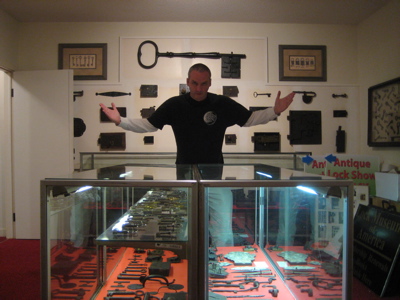
And I loved it. So did Dan, who was wrapping up his day long CTMQ adventure with me out here in Terryville at the lock museum. After a full day of museum going (you can see our itinerary for his profile of me here), Dan was positively giddy (and a bit punchy) nearing the end. For my part, I was quite happy too.
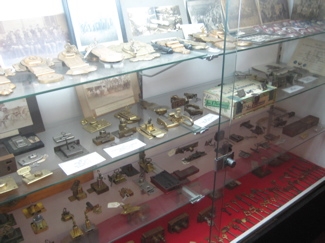
Why? Because I had shown Dan a solid day of what this website is all about. We went to a wide variety of museums, met some wonderful docents, learned a bunch of stuff we didn’t know we cared to learn and here, at the lock museum, it all came together for him (I think). Totally random, singularly devoted to one subject (Locks!), and decidedly quirky, I had created a convert in Dan. He grew up in Connecticut and went to Yale, but like 99% of the public, had never really delved into the seemingly mundane to find the exquisite. Now he had… And like I said, he was loving it.
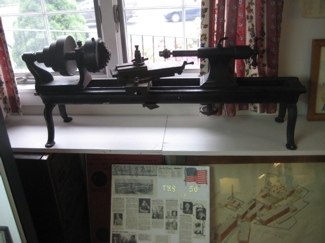
Not that either of us gives a hoot about locks. They are merely functional and important little pieces of hardware that we navigate several times a day without thinking about them. We lock our houses with tumbler locks. Our cars with automated locks. We get into our office buildings with magnetic strip reader locks. Unlock our desks with little crappy key locks. And thankfully there are those out there who find beauty and historical significance of these things to the extent that they’ve put together an incredibly large display of them in a museum setting.
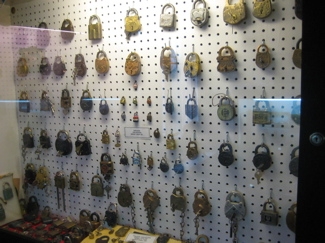
I shouldn’t have been surprised at the size of the collection. After all, I was wowed a few miles away at the American Clock & Watch Museum in Bristol just a month prior. (CTMQ Visit here.) Here in the industrial heart of Connecticut, where brass implements (Waterbury), clocks (Bristol/Waterbury), machine parts (New Britain) and locks (Terryville, New Britain) were made for national and international markets for years, there is a rich history of these things and several museums celebrating each towns’ past.
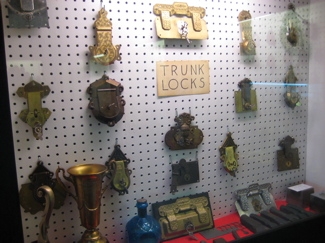
Which reminds me… 107 museums ago, way back at my very first museum visit at the New Britain Industrial Museum (CTMQ Visit here), I had made a deal with the tour guide there. While showing us the comparatively small collection of Russwin and Corbin locks there, the guide had complained about the Lock Museum saying something about how they got a huge amount of grant money whereas the Industrial Museum got nothing.
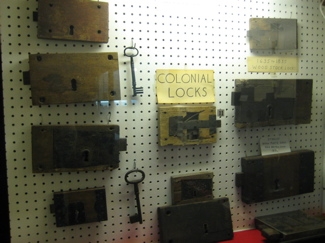
I promised him that when I made it out to the Lock Museum that I’d give them the business and ask them to donate some of their New Britain made locks to the Industrial Museum. I was totally prepared to do it too… But as you’ll read, that turned out to be an impossibility.

Built on the site of the original Eagle Lock Company, which began making locks in 1854, the Lock Museum of America chronicles lock-making history–a chapter in mechanical engineering lore. The eight display rooms house more than 23,000 kinds of locks, including vault locks, door locks, and padlocks.
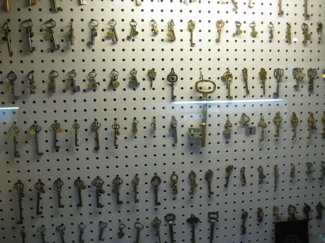
Think about that for a second. Twenty-three THOUSAND locks. As you can imagine, The Lock Museum of America holds the largest collection of colonial and antique locks in the United States. I told you, this place is awesomely insane.
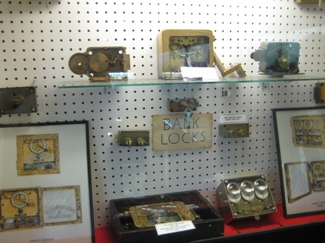
Dan and I entered, paid the entrance fee and were guided by an older woman to the center of the first room. The museum is impeccably neat and obsessively organized – as it must be. As Dan and I spun around in wonderment at the locks before us. At this point, I think we thought that this room was the entire museum, which would have been more than enough. Little did we know that this was only about a third of the collection.
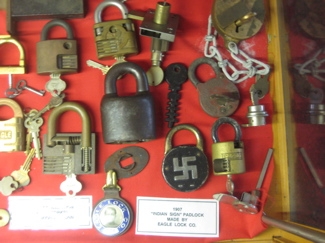
The woman smiled at us, walked over to a wall panel and pushed a button. The next thing we knew, we were being “guided” by the pre-recorded voice of (I assume) Tom Hennessey. This was a first for me: A tape recorder tour guide. Not only that, but the gravelly recorded voice emanating from the tinny speakers was unintentionally hilarious.
Even though the kindly woman had probably heard the recording a thousand times, she couldn’t contain her laughter at the disembodied voice of (I assume) Mr. Hennessey. The recording could have used a couple retakes at certain places, like when “the voice” would suffer a coughing fit or stumble hopelessly on a phrase.
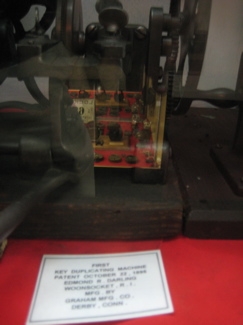
The first key duplicating machine!
It was pretty funny, but c’mon… The narrator sounded like he was 115 years old and he was clearly passionate about locks. What more could a museumgoer ask for? The lady took leave of us and we were free to enjoy the tour, such as it was, on our own.
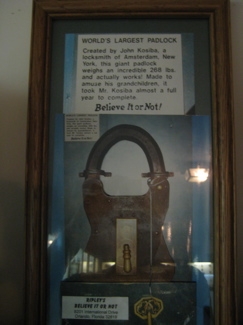
The world’s largest padlock!
At this point, I think I could easily get away with simply posting 30 pictures of locks and be done with it. I didn’t take any notes during my visit because really, I think all they would say is “locks, locks, locks. Locks, locks, locks. More locks! Morlocks?”
Yeah, now that would be cool. Sort of a melding of the Clock & Watch Museum with the Lock Museum! Morlocks are cool. (Morlocks are a fictional species created by H. G. Wells for his 1895 novel, The Time Machine. They dwell underground in the English countryside of A.D. 802,701 in a troglodyte civilization, maintaining ancient machines that they may or may not remember how to build. Their only access to the surface world is through a series of well structures that dot the countryside of future England.
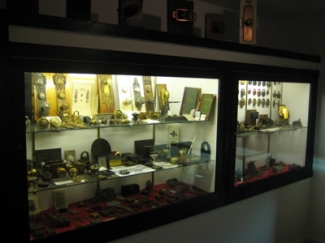
Morlocks are humanoid creatures, said to have descended from humans, but by the 8,028th century have evolved into a completely different species, said to be better suited to their subterranean habitat. They are described as “ant-like”, because they possess the ability to crawl up walls.
Morlocks wear no clothing but are covered with fur. As a result of living underground, they have little or no melanin to protect their skin, and so have become extremely sensitive to light.
I always appreciated Wells’ foresight and intelligence to set The Time Machine so far into the future. Anyway, there were no Morlocks at the Lock Museum, and this aside has now gone on too long. Let’s look at some real locks already.
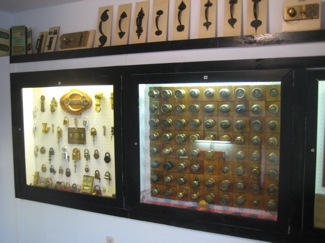
As I said, the museum boasts eight display rooms. This first one contains 23 different displays and “The Voice” walked us through each one, which as it turns out, is a pretty efficient way to go. I found myself rather enjoying it and even if you get lost in one particular bunch of locks, you can catch up with “The Voice” later as each display is numbered.
In a nutshell, the first floor contains displays containing Eagle Locks, trunk locks, padlocks, keys, cabinet locks, bank locks, colonial locks, Branford Rim locks, auto locks, old key machines and the museum hall of fame.
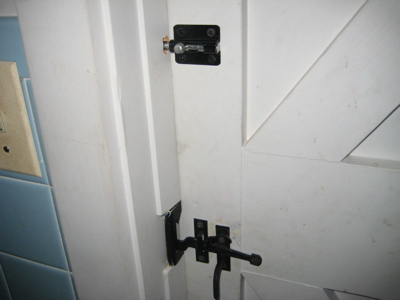
The museum’s bathroom door lock
And I must mention the various collections around the room which contain – you guessed it – more locks.
Before heading upstairs to check out some more, um, locks, let’s learn a little bit more about one of the driving forces behind this singularly devoted place. (Info taken from some Bristol Herald article reprint I picked up at the museum.)
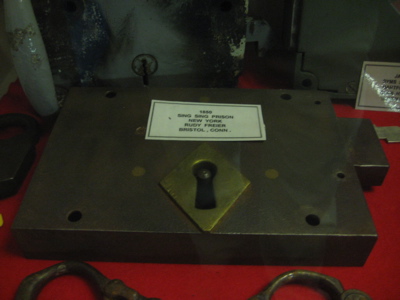
Old Sing Sing Prison jail lock
Tom Hennessey had a long career in the lock-making industry. Once retired, he didn’t stray far from his craft and is still involved with locks as much as he ever was. Heck, he even authored a book called Locks and Lockmakers of America.
“It’s become the bible of the lock industry,” Hennessey says. He could discuss pins, tumblers and keys for hours. (I believe it.) The cuts on a key push the pins. When they’re all lined up properly the lock opens. And, as proven by an ancient Egyptian lock at the museum, the fundamental design has remained the same for at least 4,000 years. “It’s like a knife, fork or spoon,” he said. “It won’t change.”
Once upon a time, lock manufacturers prospered in Terryville, New Britain, New Haven. “Connecticut was the center of lock making,” Hennessey explained.
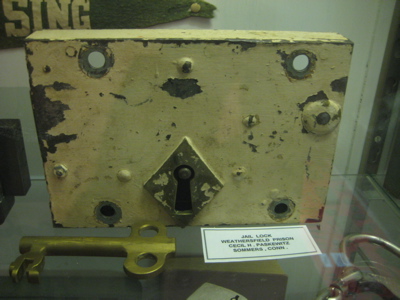
Jail lock used in Wethersfield’s old prison (CTMQ “visit” here)
In Terryville, the landmark Eli Terry Jr. Water Wheel was used to operate machinery at one of America’s first lock factories, Lewis Lock Company, in the early 1850’s. It is the only known original manufacturing water wheel left in the country. CTMQ notes: I can’t believe I didn’t make the two block trek westward to check it out. I have driven by it and will certainly make a trip out there soon and update this page. This 20-foot-in-diameter water wheel has a gear around the circumference that adds speed to the shaft which was used to operate the machinery of the factory.
Hennessey was one of the founders of the lock museum and has been curator since it opened in 1972. The museum has grown from a small storefront to the eight current rooms.
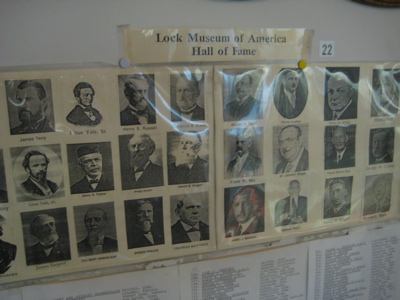
Yes folks… The lock Hall of Fame
Hennessey recently received a box from a Burt Spilker of Baltimore with over 300 keys and assorted locks. Some are over 1,000 years old and date back to Roman times – the collection is valued at around $300,000.
Holy cow. Lock that thing down!
Going back to the Industrial Museum’s lament, the lock museum got a $50,000 contribution from the Yankee Securities Convention, which is some sort of lock group.
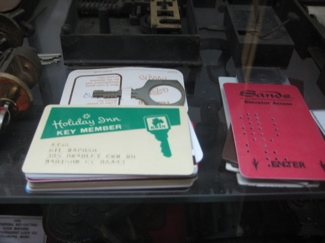
And check this out: Hennessey’s lock expertise has taken him on some interesting travels. He set up the key systems at SMU in 1963 and saw President Kennedy’s motorcade pass by about five minutes before he was assassinated. He also set up the key in system for the World Trade Center which had 46,000 Corbin locks. Hm, maybe this guy should stop traveling.
Let’s go upstairs.
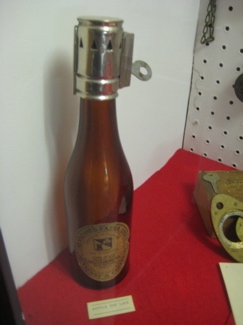
Beer lock!
The newest room exhibit is an extensive lock collection that includes a Cannon Ball Safe, 30 early era time locks, Safe Escutcheon Plates and a large number of British Safe Locks, Door Locks, Padlocks, Handcuffs and Keys. Another display room, known as The Eagle Lock Company Room, contains over 1,000 locks and keys manufactured from 1854 to 1954.

Independence Hall replica lock and key!
The Bank Lock Room comprises a selection of bank locks, vault locks, safe locks and time locks. The Corbin-Russwin Room contains a large display of ornate hardware. Several pieces are gold plated and enameled. One of the animated displays shows how a pin tumbler lock works.
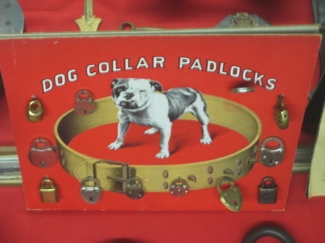
Recently added is a large, 20′ long display of mounted door knobs and escutcheons made by Russwin and P & F Corbin during the Victorian era. These are extensively detailed in styles such as Roman, Greek, French and Italian Renaissance, Gothic, Flemish, and Elizabethan English.
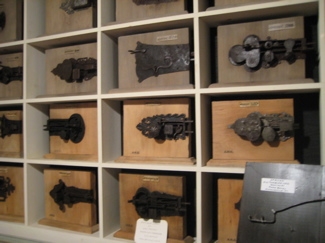
The Yale Room accommodates locks manufactured by the company from 1860 to 1950. One of the attractions here is the original patent model of the Mortise Cylinder Pin Tumbler Lock designed by Linus Yale Jr., in 1865. While this device is considered the greatest invention in the history of lockmaking, it is certainly not without historical precedence. Close by is that 4,000 year old Egyptian made pin tumbler lock.
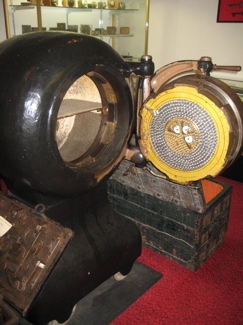
There is also a large display of locks and hardware made by Sargent and Co. in New Haven, Ct. Several early exit devices and door closers are on display as well.
And finally, the Antique Lock Room contains a large display of colonial locks and Ornate European Locks dating back to the 1500’s.
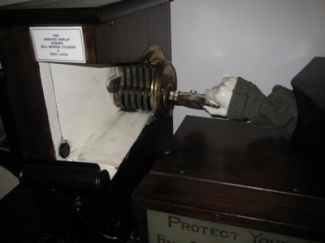
You get the point. There are a lot of locks at the Lock Museum of America. Perhaps my favorite little display in the whole place is the front gate lock from none other than the Lock Museum of England! Yes, the two venerable institutions traded door locks to display in each other’s museums a couple decades ago. I don’t know why, but that cracked Dan and me up.
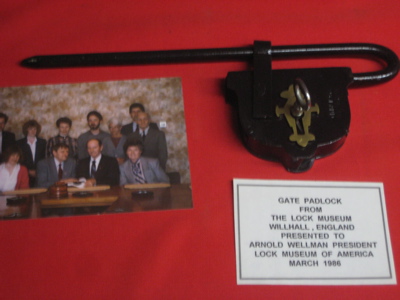
The one, the only… Gate lock from the Lock Museum of England!*
*Update! Just found this on the Intertubes: Willenhall (in England) is famous for the manufacture of locks, and the UK’s National Lock Museum was situated within the town until it closed in December 2008 due to the withdrawal of funding by Walsall Metropolitan Borough Council. I’m actually somewhat upset by the news… And I just emailed it to Dan too. We care.
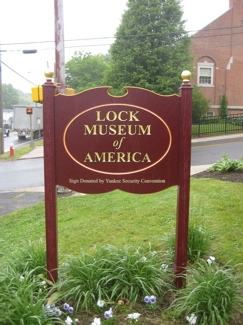
As you can clearly see from my pictures, if locks are your thing, this is your heaven. And apparently Dan likes locks. The time was getting late and we had to get back through Bristol to Farmington to pick up Damian, but Dan just didn’t want to leave. He was furiously taking notes (and I took none and yet was able to craft this wonderful posting) and smiling at each new lock discovery.
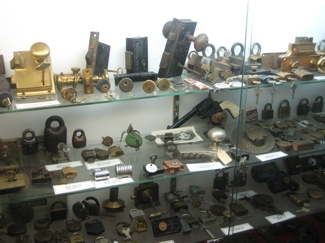
At the least, I can say that Dan surely told someone about his visit to the Lock Museum and for that, I can be happy. I’ve successfully indoctrinated another person into my crazy world.
Lock him up and throw away the key. And now, some more pictures (you won’t believe how many I didn’t include.)
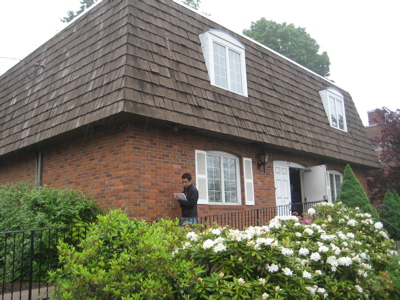
![]()

 christina says
christina says
February 13, 2013 at 10:03 pmHi, I am looking to date a Skelton key. I know this much it was made in Italy and it is approx. 7-8 inches long. When you turn the handle the top piece pulls apart and reveals a letter opener or dagger of some sort.
Could you help me and figuring out when it might have been made or when they were made.
Thanks
Christina
 Steve says
Steve says
February 13, 2013 at 11:44 pmA dagger? Good. Stab yourself in the thigh with it.
 Ronald says
Ronald says
February 21, 2013 at 11:59 pmI came across an Eagle Lock company lock on a piece of furniture I bought that I am looking to date. The lock says s4k18 and is a square base with a post that sticks out which goes through the drawer. It was a single drawer dresser of some sort. Any idea?
 Steve says
Steve says
February 22, 2013 at 9:37 amAh, yes, the good ol’ s4k18. When dating locks of this sort, you have to be careful. They are what we call “lock-teases.” Your date will be going along great… dinner, flowers, the whole thing and s4k18 will totally be flirting with you, giving you those pin and tumblers you always fall for so hard.
But then, just when you think you’re gonna get some hot locking action, she lock-teases you.
So I wouldn’t want to date an s4k18.
 Ed DeNeale says
Ed DeNeale says
April 30, 2013 at 12:01 pmI have a key that has P & F CO etched in it and a number 3 on it. How old is it? It is a skeleton key
 Joan sanders says
Joan sanders says
September 2, 2013 at 4:59 pmI just bought a big padlock with key at an antique auction in Georgia. Can I send a photo somewhere to help identify and find out if its worth I paid. Thanks!
 Chris K says
Chris K says
September 3, 2013 at 12:38 pmSteve,
I am the Gatekeeper. Are you the Keymaster? If not could you date this ancient Sumerian lock I have?
Thanks,
Zuul
 Chuck says
Chuck says
January 31, 2014 at 9:22 pmI have a antique surveying instrument housed in a carrying case with a eagle lock #76P217.
The instrument and the lock has the date March 15 1892.
Any ideas on how to get more info?
Thanks
 Michael says
Michael says
April 20, 2014 at 6:48 pmWe found an Eagle Lock Co. (Terryville, CT), key, #13C11, among my wife’s deceased parents’ belongings In Minn.
It reminds me of a railroad switch lock key, but since it is not stamped with a railroad’s initials, I think it must be for another type of lock. It is almost two-inches long and seems to be of brass. Has a hollow tube with one end flattened to a circle with a hole in the middle.
Any idea what it can be?
 Halie says
Halie says
July 27, 2014 at 8:38 pmI have an Eagle lock co. Trunk key with the number 30 on it. Can you tell me roughly what year?
 Gloria says
Gloria says
September 3, 2014 at 4:52 pmWe are restoring a historical home in Boulder City, NV and have Sargent locks on the doors. They are #605A, 607A, 609A, 612A, & 625A. I have only one key 613A. I continually keep my eye on ebay but have not found any. Any help would be appreciated.
 HAWK OLIVERA says
HAWK OLIVERA says
November 13, 2014 at 7:47 pmMY NAME IS HAWK OLIVERA ADOPTED NAME SANTOS VIDAL REA I AM THE RIGHTFUL HIER TO SEVEN OF THE WEALTHEST MONARCHS OF THIS WORLD QUEEN ELIZABETH THE SECOUND IS MY STEPMOM I AM THE GRANDSON OF THE LAST IMPERIAL MONARCH KING. I AM BEEN HELD HOSTAGE IN SELMA,CALIFORINA BY DWIGHT NELSON PLEASE SEND HELP I REPEAT THIS IS NO JOKE NEED MARSHALL LAW IN CALIFORINA NOW LIFE OR DEATH
 Steve says
Steve says
November 15, 2014 at 6:32 pmWhat’s awesome about this insane spam is that it’s not too different from the insane lock people above.
 HAWK OLIVERA says
HAWK OLIVERA says
January 5, 2015 at 2:53 pmMY NAME IS HAWK OLIVERA I WAS ADOPTED FIRST BY QUEEN ELIZABETH THE SECOUND OR I KNOW IT SOUNDS A LITTLE FAR FITCHED BUT IT TRUE . QUEEN ELIZABETH THE SECOUND OR HER YOUNGER SISTER OR GRACE KELLY FROM MOROCO ,ONE OF THESE LADIES IS MY BIRTH MOM AND THE OTHER IS MY STEPMOM AND OR GODMOTHER. IN 1967 ME AND MY FATHERSIDE OF THE FAMILY HERE IN THE U.S. WERE SHOT AND I WAS THE ONLY ONE TO LIVE . I HAD TWO SHOT IN THE HEAD 2,500 STICHES IN MY THREE YEAR OLD HEAD THEY CALLED IT A HUNTING ACCIDENT, ANYWAY I WAS SONE ADOPTED BY MY FIRST COUSIN AND HIS WIFE FROM KERN COUNTY THAT RAISED ME HERE IN SELMA,CALIFORINA AS HIS SON, HIS NAME WAS SANTOS FRANK REA . IN 1968 IN 1969 WE MOVED TO SELMA, AND IN 1972 MY SECOUND GRADE TEACHER TRIED TO BEAT THE INDIAN OUT OF ME ,EVERYDAY SHE WOULD BREAK A RULER OVER MY HAND BECAUSE I WOULD NOT WRITE SANTOS JR. I WOULD TELL HER MY NAME IS HAWK I AM IN AMERICAN INDIAN. THAT YEAR WE HAD A FIELD TRIP TO HER HOUSE OF ALL THINGS , WE ALL HAD A 2X3 WHITE PAPER TO PUT OUR HANDS INFINGER PAINT AND MAKE PRINTS OF OUR HANDS BUT I WAS THE ONLY CHILD SHE TOOK INSIDE AND TOOK PICTURES OF MY FACE WITH A INSTINT MADIC CAMERA. I KNOW FOR A FACT SHE NOT ONLY FOUND OUT THAT I WAS STILL ALIVE BUT THAT I WAS ROYALTY THE LOST IMPERIAL MONARCH KING OF 1968 WORTH TRILLIONS. EVER SINCE 1976 DAVE HELM ,DWIGHT NELSON ,EHCO HAWK AND A MR. DOMINUEZ FROM LOS ANGELES HAVE PARTNERED UP WITH RICH FARMERS DAIRYMEN RANCHERS FROM CALIFORINA TO STEAL NOT ONLY THE INTREST OFF OF MY INHERTINCE BUT MY INDENTY MY TAXES MY MAIL MY GIFTS IN THE MAIL. DWIGHT NELSON REALLY THINKS HE IS ME AND THAT HE CAN DO WHAT EVER HE WANTS TO DO BECAUSE MY INHERTINCE MADE HIM POWERFUL ENOUGH TO KILL GRACE KELLY AND GET AWAY WITH IT I WANT THE WORLD TO KNOW WHAT IS GOING ON HERE IN SELMA,CALIFORINA . I AM THE RICHES MONARCH KING TO WALK THE FACE OF THIS EARTH AND YET DWIGHT NELSON HAS KEPT ME HOMELESS MONEYLESS CARLESS FOR 20 YEARS NOW. I HAVE YET TO SEE ONE DIME OF MY INHERTINCE.I NEED HELP HERE IN SELMA,CALIFORINA MY BLOOD TYPE IS WHAT SETS BE APART FROM THE OTHER FAKE HAWK OLIVERA’S MY BLOOD SAVES LIFES. HE IS A FRAUD A LIAR AND HAS BRIBED THE GOVERMENT THE COURT SYSTEM I NEED UNITED NATIONS TO STEPIN AND GIVE HIM AND ME A LIE DEDCETVIE TEST PLEASE THIS IS NO JOKE MY LIFE IS ON THE LINE
 HAWK OLIVERA says
HAWK OLIVERA says
January 5, 2015 at 2:57 pmplease someone tell your friends to look in to this it is easy after 39 years of research i know what i am talking about just look up www. ALLGOV.com hawk olivera adopted name santos vidal rea or http://www.HAWK OLIVERA TEXAS OIL TYCOON MY BIRTHMOM LEFT ME LAND AND MINERAL RIGHTS FROM FLORIDA THUR TEXAS THE BIGGEST OIL COMPANY IN AMERICA MY BIRTHFATHER WAS KING OF PORTUGAL
 Gregg says
Gregg says
March 19, 2015 at 6:10 pmThe big skeleton key that u have displayed in your pictures as a replica, I have the same key that has been past down from the family. I know have it in my collection of locks and keys but have no idea as of it’s use or age I know if came from my great great grandfather but it has no markings to track it or use, do u have any ideas? Thanks
 Diana says
Diana says
May 11, 2015 at 10:45 amHello. I have a cabinet door with a hunt scene painted on its black lacquer front (red n back) painted in 1948.
The hinges were removed probably by the painter but not sure. But the door has Eagle lock no 398 on back and key hole on front.
Can you tell me anything of the lock? I believe Eagle Lock Co. Did make cabinets as well so anything on this would be great to. I can send you a pic if that is helpful
Thank you
Diana
 john teeter says
john teeter says
January 2, 2016 at 6:30 pmI have a ,what I believe to be ,Victorian brass doorknob on the front door of my 1860’s house.the inner mechanism quit working.i can’t get the doorknob apart.the outside nob has a screw in the middle of the handle.have you ever seen one of these ?
 tim says
tim says
May 17, 2016 at 7:24 pmcan anyone tell me about this it’s like a salesmans demo Corbin lock set on a piece of wood looks like a small door
 Barbara says
Barbara says
November 7, 2016 at 2:19 amI’m looking for the complete series of Q Corbin Skeleton keys for a friend. If you have any, could you make a copy to sell?
Please email me to let me know.
 mike says
mike says
February 9, 2017 at 9:20 pmHave an Eagle Lock #2701 with key. Would like to know when manufactured & approx value.
 Don Hart says
Don Hart says
February 22, 2017 at 4:19 pmI have an eagle lock I’m trying to find a date. Can you help? I can text you a picture if I have a phone number to text it to. Thanks ….Don
 Don Hart says
Don Hart says
February 22, 2017 at 4:21 pmDon hart’s phone is 503-501-7091
 Devid bekalaze says
Devid bekalaze says
March 10, 2017 at 2:41 amCTMQ here – of course I’d typically delete this comment, but on the lock museum comment thread, this seems to be okay.
Dear Sir /madame
We are Mukwano suppliers (U) Ltd.We are East Africa’s
leading Baby Diaper and chemicals supplier We are very much
established, credible and big supplier of various goods in East
Africa. We supply various countries We would like to buy your product
in large quantity.
Solid brass Padlock
ortise open case standard cylinder lock
Mortise open case lever
we want to start business relationship with a credible company to
expand our distribution capacity.
Hence the reason to source for credible and dependable long term suppliers.
Please forward us your packing list and quotations
Kindly get back to me as soon as possible
Thanks & Regards,
procurement manager
Devid bekalaze
Mukwano suppliers (U) Ltd
Plot 301 industrial area
P. O. Box 6959, Kampala – Uganda
Tel: +256 704408753
Fax: +256-413-280-698
Email:mukwanoltd@gmail.com
http://www.mukwanosuppliers.info
 Gary Kosiba says
Gary Kosiba says
May 16, 2019 at 1:54 pmI am checking to see if that largest padlock is currently at the lock smith museum in Terryville
 'Sarah Hillcrest says
'Sarah Hillcrest says
May 23, 2019 at 3:30 pmI have five antique keys — all marked “Taylor” with five different key numbers: 517, 518, 526, 536 and 538. They were used in a building built in 1829 in the southeast United States.
I have been unable to find any information on the Taylor Key Company that existed in 1829, and no information on these specific five keys.
Any help you could give me in learning about the origin of these keys would be greatly appreciated.
Thank you very much.
 thomas chubinsky says
thomas chubinsky says
September 30, 2020 at 3:19 pmMy name is Thomas Chubinsky and I work at Phoenix College. We are looking to donate 1930,s to 1950’s lock mortises,norton bell bottom closers,mortise knob sets from sargent to yale please contact me if intrested
 Jennifer EGERMIER says
Jennifer EGERMIER says
December 17, 2024 at 1:32 pmHello. I was metal detecting an old plantation area in SC. I found some sort of plate. it looks to be hand forged, not fancy. square screw holes. a really jagged notch in the center. it has a single intital in it. J. I feel like it a face plate of some kind of lock. I can’t find anything that looks like. can u possibly help.
please and thank you